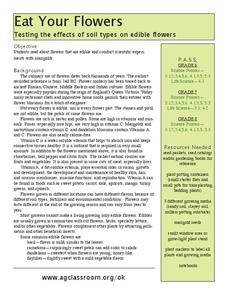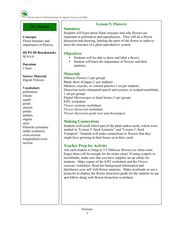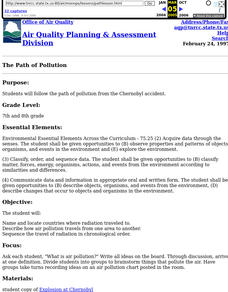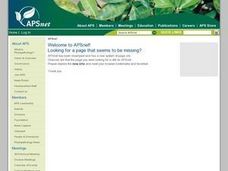Curated OER
Eat Your Flowers
Learners grow flowers in different soil mediums to determine the effect on flavor. In this investigative lesson students study flowers, plant them and taste them to see how they differ in different potting soils.
Curated OER
The Angiosperms
Students study angiosperms and their classifications. In this investigative lesson students compare the sexual reproduction of angiosperms and seed formations.
Curated OER
Dry Forest: Flowers
Students explore botany by examining diagrams. In this plant reproduction lesson plan, students define a list of plant vocabulary terms and identify plant anatomy from a diagram. Students complete several plant activity worksheets and...
Curated OER
Living Corn Necklace
Fifth graders explore heredity and observable traits through experimentation. They view several different types of corn and record their observation of physical traits on a class chart. They create a corn necklace by sprouting dried...
Curated OER
Forest Activity: Interpreting a Graph
Learners research forest growth online. They analyze the parts and contents of a graph, then summarize in narrative form the changes in the forest over time.
Curated OER
The Path of Pollution
Young scholars follow the path of pollution from the Chernobyl accident. Students name and locate countries where radiation traveled to, describe how air pollution travels from one area to another, and seqence the travel of radiation in...
Curated OER
Observing Plants Through a Journal
First graders observe a plant, write about it, and illustrate their writing in a journal.
Curated OER
Dino Dung!
Learners examine how there is more to poop than they think! After reading through material, they answer a series of questions on coprolite, and explore the diet and physical attributes of dinosaurs, as well as their environment.
Curated OER
Water Molds (Oomycetes)
Pupils explore a group of fungus-like organisms; the Oomycetes, by baiting them from natural sources (water and soil) and observing them.
Curated OER
Let's Catch Some Dirt From the Air
Students create "catchers" that collect dirt particles from the air. They observe the particulate matter that is collected from the air and discuss the effects and causes of air pollution.
Curated OER
Particulate Matter: How Dirty is the Air We Breathe?
Fourth graders create a simple testing device and collect and observe the pollution in the air we breathe.
Curated OER
Mission Planning: Earth/Mars Comparisons
Students compare and contrast conditions on Mars to those on our own planet, specifically, their local or regional environments. The physical characteristics, the atmosphere, and other astronomical data is considered.
Curated OER
Indoor Air: What's the Matter?
Students develop a greater awareness of the variety and amount of particulate matter in the air. They try to locate general sources of pollution for a specific area and develop some suggestions for improving air quality.
Curated OER
Pecan Fingerprints
Students investigate the traits that make them individuals. They study that natural items have traits that make them unique by looking at pecans. They make fingerprint animals which they use to design fingerprint cards.
Curated OER
I Breathe What?
Young scholars participate in an experiment in which they gather and examine particiles in the air. They place pollution detectors at different locations and identify problem areas. They discuss how engineers can use this type of...
Curated OER
Particulate Matter: How Dirty is the Air We Breathe?
Fourth graders work together to collect air samples for testing. They determine the amount of pollution in the air in their community. They discuss their results to end the lesson.
Curated OER
Make Way for Wild Migrants
Students discuss the threats facing migratory species and track the seasonal journeys of wildlife in real space and in cyberspace. Once they have gathered information from several sources, they create a portfolio to share with others...
Curated OER
The Path of Pollution
Students conduct a brainstorming exercise that asks them to list all the ideas about air pollution that can be recalled. The ideas are recorded on a chart that the teacher has prepared. The lesson contains sufficient background...
Curated OER
Air Pollution: Visible And Invisible
Fourth graders observe air pollution that is visible and invisible with experimentation. During the experiment the students collect data that needs analysis. The observations are recorded in the lab journal. The data also is represented...
Curated OER
Insect Communication and Harmful Insects
Seventh graders use children's literature in order to create an interesting context for the instructional activity. The concept of insect communication is investigated in order for students to form educated hypothesis guesses.
Curated OER
Bigger Flowers
Students observe and compare real flowers and artists' paintings of flowers. They discuss a flower and its parts. Students discuss the color (color wheel) and are introduced to new vocabulary. They draw, color, or paint a large flower...
Curated OER
LISTENING TO DIRECTIONS
Students view farm objects or products made from farm animals and follow the oral instructions given by the teacher. They are given worksheets, there are three sets of directions for the one worksheet. Students worksheets have everything...
Curated OER
IN STRAWBERRY FIELDS
The student will calculate wages of agricultural workers by the hour and by the piece.2. Share background material, and discuss the difference between gross pay and net pay and the difference between getting paid by the hour or the piece...
Curated OER
Bumblebee Dot To Dot
In this science worksheet, 2nd graders will complete a dot to dot. Students will connect the dots from one to thirty-one to create a flower for the bumblebee.
Other popular searches
- Bees and Pollen
- Pollen Activity
- Spores and Pollen
- Climate Change and Pollen
- Pollen Peeper Evolution
- Insects, Pollen
- Pollen Germination
- Pollen Cones
- Pollen Tube Growth
- Bees Pollen
- Insects Pollen
- Pollen Grains


